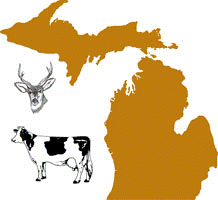Wildlife Disease and Zoonotics
Date of this Version
2004
Abstract
Apparent prevalence, although useful as a consistent index, may underestimate the true prevalence of disease. In Michigan, the ability to estimate the true prevalence of bovine tuberculosis (TB; caused by Mycobacterium bovis) in free-ranging white-tailed deer (Odocoileus virginianus) will become increasingly important to accurately assess progress towards eradication. Our objectives were threefold: to estimate the true prevalence of M. bovis in free-ranging deer in Michigan, to evaluate the effectiveness of existing TB surveillance methods, and to indirectly assess whether TB epidemiologic data from captive cervid herds can be meaningfully extrapolated to free-ranging populations. The study population consisted of all free-ranging deer submitted for TB testing in 2001 from six townships in northeastern Lower Michigan. Tissue samples of tonsil and cranial lymph nodes were collected bilaterally from all deer eligible for the study that did not have gross lesions suggestive of TB (n=701). Samples were subjected to histopathologic, acid-fast (AF) staining, mycobacterial culture, and polymerase chain reaction (PCR) testing. Seven deer cultured positive for M. bovis that would not have been detected by current surveillance, yielding apparent and true prevalence estimates (95% confidence limits) of 2.7% (1.6, 3.8) and 3.6% (2.3, 4.9), respectively. The sensitivity, specificity, and positive and negative predictive values of the current surveillance protocol were 75, 100, 100, and 99%, respectively. Histologic lesions were present only in tonsils, and ranged from simple necrosis to caseation, suppuration, and granuloma formation. Acid-fast staining and PCR detected M. bovis in only one of the seven culture-positive deer. Our study provides the first estimate of the true prevalence of M. bovis in Michigan’s free-ranging deer population and suggests modest underestimation of that prevalence by current surveillance. This study also suggests that caution is warranted when extrapolating epidemiologic data on TB in captive cervids to free-ranging populations and confirms the pivotal role of the tonsil in early infections.



Comments
Published in Journal of Wildlife Diseases, 40(1), 2004, pp. 42–52.